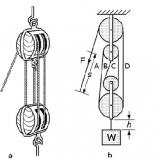TRACK-DRIVE LOCOMOTION – 21139
When neither wheels nor legs effectively propel a robot over a surface, track-drive locomotion sometimes works. Track drive is used in military tanks, and in some construction vehicles.A track drive has several wheels and a pair of belts or tracks, as shown in the illustration. (This drawing shows only one side of the track drive.
An identical wheel-and-belt set exists on the other side, out of sight in this perspective.) The track can be rubber if the vehicle is small; metal is better for large, heavy machines. The track can have ridges or a tread on the outside; this helps it grip dirt or sand.
Assets
Track-drive locomotion works well in terrain strewn with small rocks. It is also ideal when the surface is soft or sandy. Track drive is often the best compromise for a machine that must navigate over a variety of different surfaces. A special advantage of track drive is that the wheels can be suspended individually. This helps maintain traction over stones and other obstructions. It also makes it less likely that a moderate-sized rock will tip the robot over.
Steering is harder with track-drive than with wheel-drive locomotion. If the robot must turn right, the left-hand track must run faster than the right-hand track. If the robot is to turn left, the right-hand track must run faster than the left-hand track. Steering radius depends on the difference in speed between the two tracks.
Track drives can allow robots to climb or descend stairways, but for this to work, the track must be longer than the spacing between the stairs. Also, the whole track-drive system must be able to tilt up to 45°, while the robot remains upright. Otherwise the robot will fall backwards when going up the stairs, or forwards when going down. A better system for dealing with stairways is tri-star wheel locomotion.
Limitations
One potential problem with track drives is that the track can work its way off the wheels. The chances of this are reduced by proper wheel and track design. The inside surface of the track can have grooves, into which the wheels fit; or the inside of the track can have lip edges. The track must be wrapped snugly around the wheels. Some provision must be made to compensate for expansion and contraction of the belt with extreme changes in temperature.
Another problem with track drive is that the wheels might slip around inside the track, without the track following along. This is especially likely when the robot is climbing a steep slope. The machine will sit still or roll backwards despite the fact that its wheels are turning forwards. This can be prevented by using wheels with teeth that fit in notches on the inside of the track. The track then resembles a gear-driven conveyor belt.
On smooth surfaces, track drives are usually not needed. If a surface is extremely rugged, robot legs or tri-star wheel locomotion generally work better than wheels or track drives.




